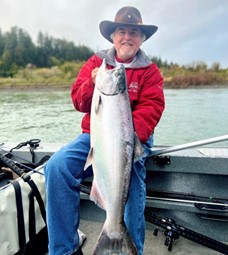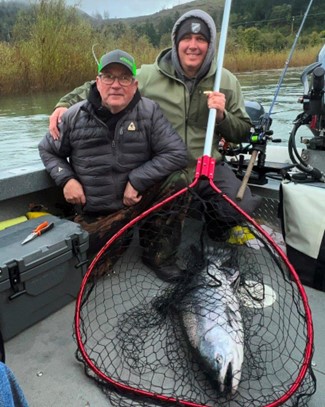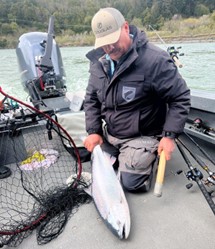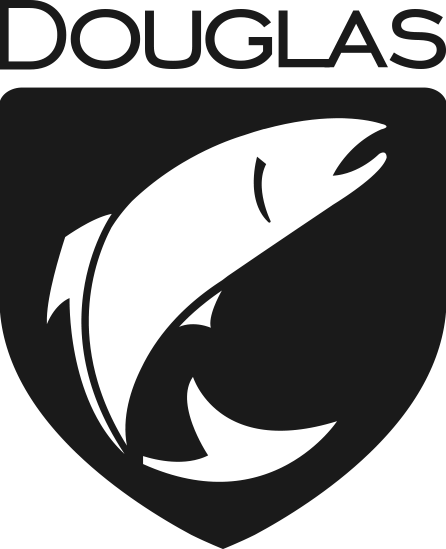by Buzz Ramsey
Late March, April and May are the months anglers chase Spring Chinook in the Pacific Northwest. To Northwest anglers, Spring Chinook are worthy of more than a little attention as they are the best eating salmon the region has to offer.
You see, Spring Chinook are different than chinook caught the same time of year (as feeders) in the ocean, Puget Sound or Great Lakes region because it’s during the spring that they migrate up rivers toward the hatchery or natural habitat that produced them. Chinook that migrate up rivers in the spring then hold over all summer (in cool water sanctuaries high in watersheds) before finally spawning in the fall.
Because of the need to survive this long holdover period, salmon entering rivers in the spring months carry with them enough energy stores (as in fat laden flesh that includes rich omega-3 fish oils) to survive all summer without eating. It’s this extra rich flesh found in Spring Chinook that anglers savor.
And while the most popular sport fisheries for Spring Chinook are those found in the Columbia River and tributaries like the Willamette River, southern Oregon’s Rogue River offers Spring Chinook action starting near its mouth at Gold Beach Oregon.
If you’re looking for a different kind of fishing experience for thick-bodied Spring Chinook that average 20 pounds and can tip the scale at 30 or more the lower Rogue River is one fishery you should not overlook. It’s not too early to plan a trip that might include booking a date with a reputable fishing guide.
It had been a few years since I’d visited Gold Beach, to chase these pigs of spring salmon, so when friend and fishing rod designer for Douglas Outdoors, Fred Contaoi extended the invitation to me last season, I immediately said, yes. And since traveling to the coast of southern Oregon is no small trek (it takes about six and a half hours to get there from Portland) the plan was for me to car pool with long-time friend Dave Eng of Eng Products fame, who was also on Fred’s invite list.
Lower Rogue springers pass Highway 101 on a dead run, as moving fish in a hurry to reach their spawning grounds or hatchery located east of Medford Oregon, these fish are programmed move quickly through the lower river. Because you’re targeting moving fish, the most productive fishing method is to anchor your boat in the path of their migration. It should also be notes that high runoff years, provide the best action. If the water is high or if it’s overcast, the fish will move all day long. If the water is low and clear, the best bite will likely occur in the morning and evening time periods.
Since it’s important to get one of the more productive anchor spots, fishing guide and Eagle Bay Lodging and Fishing owner Pat Hollinger, 541-556-5128, had us meet him at 5AM. We passed under the Highway 101 Bridge at nearly full speed using the light of the moon, boat head lights, and Pat’s experience to guide us upstream. We’d gone no more than a few miles before we came off plane and anchored near shore in 5 feet of water.

It wasn’t long before a fat salmon of at least 20 pounds yanked my rod down and streaked downstream as if he knew reaching the ocean was a safe bet. Dave and Pat cleared the other lines as Fred threw the anchor buoy. It was then that we floated downstream and around the corner with the hefty chinook showing no signs of tiring for an extended period. It did finally wear down enough for Pat to get a net under the adipose fin-clipped (hatchery) keeper.

Where to Find Them
You’re best success for Spring Chinook as they move through the lower reaches of Oregon’s Rogue River will be found by anchoring in 4-to-6 feet of water. You see, lower Rogue springers, seeking the path of least resistance, travel along current edges and will cut across inside corners in areas where the river bends. Anchoring along current edges often means the current on one side of your boat will consist of a flowing eddy while the current is straight running on the other.
If the water is high and off color, fish will move even closer to shore and may be found in as little as three feet of water. If the water’s clear try anchoring in 6-to-7 feet of water. Low water conditions can make the area just above tidewater “the place.” Likewise, high water will spread fish throughout the lower stretches.

What to Use
Without question the top producing set up for Spring Chinook as they navigate the lower Rogue is an anchovy rigged in combination with a small spinner blade. Our anchovies were rigged behind a 48 inch leader and held near bottom via a 17 inch weight dropper line to a sinker.

The popular way to rig up consists of a trailing treble hook half hitched on the end of a 30 pound test leader via a figure eight loop. A wire threader is used to pull the looped leader end through the bait before re-attaching a size #2 treble and placing it into the tail end of the bait. A size #2 single hook is snelled onto the leader via a slip-tie and placed up through the chin of the bait with the point of the hook embedded into its forehead, before drawing the slip-tie up enough to place a bend in the bait such that it will spin. The most popular blade colors include genuine gold, copper, 50/50 brass/nickel, and mostly chartreuse and fluorescent green colors and combinations sometimes showing nickel, gold or copper on half of the blade face.
Spinners and anchovy’s work best where there is straight running current, while plugs might be the ticket when salmon are found navigating a current edge. On one past trip to the Rogue we found success by using a salmon size Kwikfish/FlatFish on the flowing eddy side of the boat and inside corners where the softer water wasn’t enough to make our blades vibrate enough to attract salmon.

Generally speaking both spinner and anchovies are rigged using a spreader and 12-to-18 inch weight dropper line. Leaders vary from 24-to-36 inches for spinners, 40-to-50 inches with anchovy rigs. To prevent leader twist try rigging a “bead chain swivel” midway up your leader. Most anglers back bounce their outfits downstream from their craft 25-to-40 feet. Sinkers can range in size from 1-1/2 to 6 oz., depending on current speed.
If you take your own jet boat, keep in mind that you will need an anchor capable of holding your craft in what can be fast-moving water. A stainless steel Kedge (rocking chair style) anchor is what most anglers employ on the Rogue. It’s critical to be able to position your boat in the migration lane the fish are using, so being able to chock over via bow cleats is important. Some veteran guides and anglers will set two anchors the same distance out in combination, positioning them 20 to 40 feet apart such that they have total control over the diagonal position of their boat. Doing this will allow you to reposition without re-anchoring until you find the migration lane the fish are using.
The fishing rods we used included the Douglas LRS series in lengths measuring from 9′ to 10’6″ in combination with bait-casting reels filled with 65 pound test braid. In order to cover as wide a pattern as possible is why anglers employ long rods. However, the rods extending straight out the back of the boat can be shorter. Still, rods measuring at least 9′ in length are preferred as they will enable you to steer what might be a giant salmon around outboard motors and into a waiting landing net easier than short ones.
Here are the rod actions we used:
LRS C9052F 9′ Medium Heavy Action
LRS C9642MF 9’6″ Medium Action
LRS C9652M 9′ 6″ Medium Heavy Action
LRS C10642 10’6″ Medium Action
Fishing Tackle, Info and Lodging
Eagle Bay Lodging and Fishing, 541-556-5128, fishing guide Pat Hollinger.
Rogue Outdoor Store, 541-247-7142, is the main tackle store in Gold Beach and offers fishing tackle and advice.
